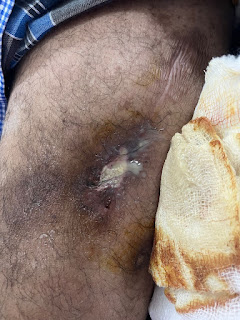General Medicine Internship Real Patient OSCEs Towards Optimizing Clinical Complexity
Introduction: This online E-log Entry Blog is an objectively structured clinical examination method to assess the clinical competence during the course of my General Medicine Internship rotation (June'2023-August'2023) by reviewing the case reports shared below and to discuss, understand and review the clinical scenarios and data analysis of patients so as to develop my clinical competency in comprehending clinical cases, and providing evidence-based inputs for questions surrounding the clinical vignettes borrowed from the E Log Book.
Note: The cases have been shared after taking consent from the patient/guardian. All names and other identifiers have been removed to secure and respect the privacy of the patient and the family.
CASE REPORT 1:
A 30-year-male, pharmacist by occupation, presented with the chief complaint of Fever since 1 week and difficulty in swallowing since 1 week. Patient was apparently asymptomatic 6 years back when he met with an accident (RTA - bike vs lorry) and sustained left femur and left tibial fracture. He underwent Intramedullary nailing and plating but complained of pus discharge from the operated site over femur, intermittently since 6 years. 1 week back developed fever, high grade, associated with chills and rigors. C/O difficulty in swallowing since 1 week, both to liquids and solids, associated with burning sensation in throat.
https://vaishnavimaguluri.blogspot.com/2023/06/32y-old-male-with-fever-and-dysphagia.html
Questions:
General Approach to the Patient:
- List all the complaints of the patient with respect to the history and relevant clinical data and mention the treatment plan for each listed problem stating its efficacy in relevance to patient relief or better outcome.
- What was the rationale behind the initial provisional diagnosis of sepsis with mods? What is the criteria for mods? What from the patient's history could signify any evidence of hemolysis? Patient's reports the day prior to admission:
Reports on admission were as follows:
Vitals on admission as follows: Temperature - 99.6F (two fever spikes in the night), Respiratory Rate - 23 cpm; Pulse Rate - 110 bpm; Blood Pressure - 100/70 mm Hg; SpO2 - 99 at room air. - On Inspection of the patient, his abdominal visceral fat is prominent.
What could be the cause for it based on the patient's history? And where inside the viscera is the fat stored? How does this visceral fat cause organ damage at the molecular level? - If the patient is in systemic inflammatory response syndrome secondary to infection, what organism could be behind the pathophysiology? Would the same organism be isolated from his blood stream and the pus discharge?
- Based on the patient's history, clinical findings and treatment what could the Anemia and Fever spikes in this patient be attributed to?
- Patient was on antimicrobial LINEZOLID 600mg IV/BD for 14 days of his hospital stay. What is the efficacy of using Linezolid over other antibiotics in this patient for chronic osteomyelitis?
- What can be inferred if no organism was isolated from the pus or blood culture sensitivity tests?
Which organisms are most likely to have been the causative pathogen and how would they have reached the site of infection or led to the symptoms? - On Day 10 of hospital stay patient Urine Input: 4200ml, Urine Output: 3400ml. On Day 11 of hospital stay patient Urine Input: 6000ml, Urine Output: 3550ml. The patient was on IV fluids in view of his sepsis leading to polyuria, in accordance to this, what proportion of sepsis patients require high amounts of fluids and what are the factors influencing this in sepsis patients?
- On Day 10 of hospital stay patient had 3 episodes of loose stools and was started on Tab Sporlac. What is the efficacy of using probiotics (sporolac) in antibiotic associated diarrhea?
- Any RCT showing the efficacy of Vac therapy as compared to conventional wound management?
- How long do patients of osteomyelitis require bedrest? What is the protocol for ambulation and physiotherapy in patients of osteomyelitis post-surgery to avoid complications of being bedridden for prolonged period such as developments of bedsores (as seen here)?











Comments
Post a Comment